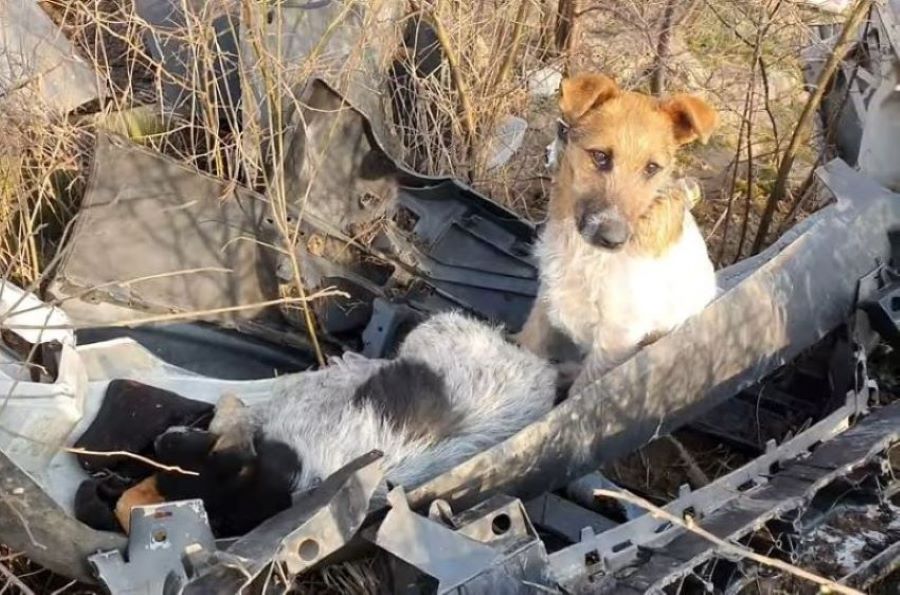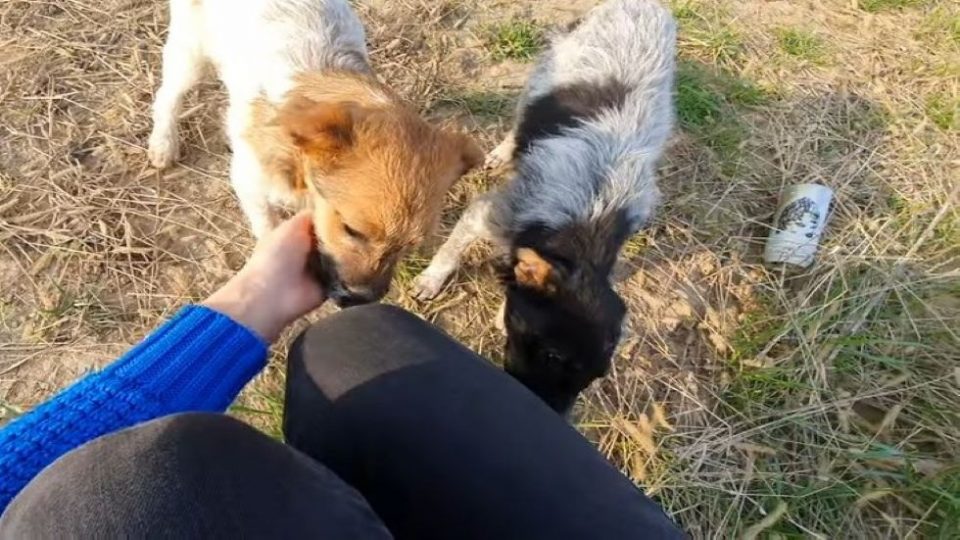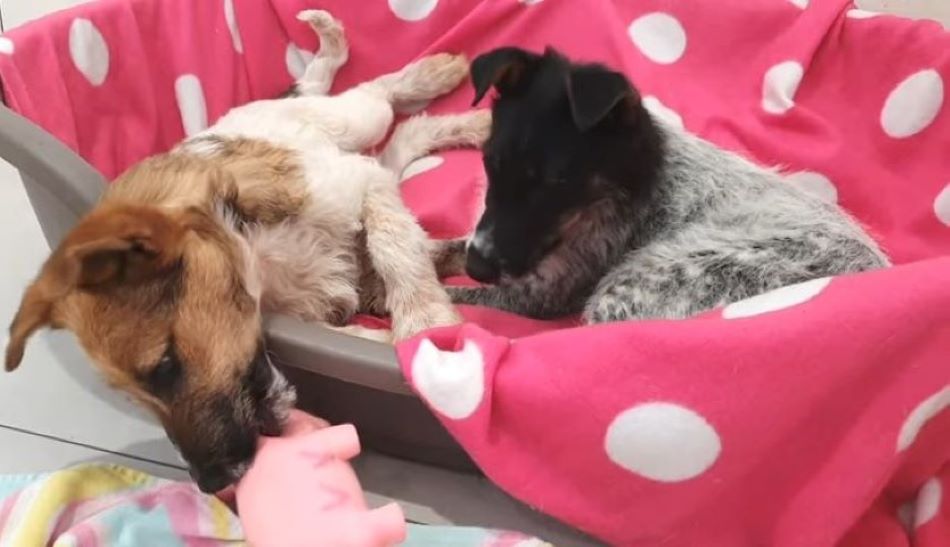Rescuing is by no means an easy job. It requires a lot of effort and mental fortitude to deal with so much heartbreak on a regular basis.
What’s even more impactful is that a lot of that comes from seeing how people treat animals and dogs.
They do not and should not be neglected or outright abused because they did nothing to deserve that.
In this story, we will talk about rescuers who were notified about two puppies who were dumped in a pile of trash.
Two Friendly Pups

After receiving the information, the kind rescuers were on their way to save these sweet puppies. When they arrived at the location, they were shocked.
They had been living in a pile of trash. One of the puppies was happy to see the rescuers while the other one was sleeping on bread.
Luckily for them, one woman noticed their misfortune and immediately contacted the rescuers from Howl of a Dog.
She felt bad for them, so she brought them some food and water until the rescuers were able to get there.

The rescuers suspect that they had been living there only for a few days, which was not too horrible. They were still very friendly and immediately greeted them.
They continued by checking the area nearby to see if there were any more dogs. When they concluded that it was only these two puppies, they focused on helping them.
Surprisingly, the woman who had been feeding them told the rescuers that she left them a bag of food, but it was gone when they arrived so it’s possible that somebody took it.
After they realized that the puppies were really friendly, they decided to name them Bonnie and Clyde.
A Safe, New Environment

They were then placed in a kennel and taken into a vehicle. Their next stop was the shelter where they could receive proper help.
After that, they noticed that Clyde appeared to be sick so they wasted no time and took him to a veterinarian clinic.
The poor pup was diagnosed with Babesiosis and had to be hospitalized because of that. The vets did everything they could to help him recover.
And, so he did. Soon after he was feeling better, they discharged Clyde from the clinic and he was allowed to return to the shelter. Luckily, they reacted in time.

He was pretty happy to see Bonnie, and the two immediately started playing around after they were reunited.
Their rescuers now knew that they were both healthy and needed a forever home, so they were placed on the adoption list.
They are only six months old, and I have no doubt that somebody amazing will give them a chance and adopt them.
While we have no information on what happened next, I remain hopeful that everything went okay for the puppies and that they are now living their best life with someone special.
If your furry friend has ever gotten their paws on some chocolate, you know the panic that can set in. Chocolate is a well-known hazard for dogs, posing serious risks to their health. As a responsible pet owner, being prepared for such situations is key to ensuring your dog’s well-being.
In this article, we’ll walk you through the essential steps to take if your dog happens to indulge in chocolate. From recognizing the signs of chocolate poisoning to knowing when to seek veterinary help, we’ve got you covered with practical advice to handle this common canine emergency.
Understanding the Dangers of Chocolate for Dogs
Chocolate contains theobromine and caffeine, stimulants that are toxic to dogs. The darker the chocolate, the higher the levels of these substances, making dark chocolate more dangerous than milk chocolate. Even small amounts of chocolate can cause various symptoms of poisoning in dogs.
Symptoms of chocolate poisoning in dogs include vomiting, diarrhea, restlessness, increased urination, muscle tremors, rapid breathing, and even seizures in severe cases. It can have detrimental effects on a dog’s heart, kidneys, and central nervous system.
The toxicity level depends on the type and amount of chocolate ingested. For example, a small dog consuming a few squares of dark chocolate is at a higher risk compared to a larger dog eating the same amount. As a responsible pet owner, it’s crucial to keep chocolate and cocoa-containing products out of your dog’s reach.
If you suspect your dog has ingested chocolate, contact your veterinarian immediately. The vet may induce vomiting or administer activated charcoal to prevent further absorption of the toxins. Treatment may also include supportive care to manage symptoms and prevent complications.
Remember, prevention is key. Always be cautious and keep chocolate away from your furry friend to ensure their safety and well-being.
Identifying Symptoms of Chocolate Poisoning in Dogs
When it comes to chocolate poisoning in dogs, recognizing the symptoms early is crucial. Here are the signs to watch out for:
- Vomiting: If your dog suddenly starts vomiting, especially after ingesting chocolate, it could indicate poisoning.
- Diarrhea: Another common symptom is diarrhea. If your dog has loose or bloody stool, chocolate poisoning might be the cause.
- Restlessness: Watch for signs of restlessness or hyperactivity in your dog. Chocolate can cause dogs to become agitated or unusually active.
- Increased Thirst: Excessive drinking or increased thirst can be a key indicator of chocolate poisoning in dogs.
- Tremors: If you notice your dog trembling or experiencing muscle tremors, it could be a sign of chocolate toxicity.
- Seizures: In severe cases, chocolate poisoning can lead to seizures. If your dog experiences seizures, seek immediate veterinary help.
- Elevated Heart Rate: Check for a fast or irregular heartbeat in your dog. Chocolate can affect the heart rate significantly.
- Muscle Rigidity: Stiffness or muscle rigidity may also occur in dogs suffering from chocolate poisoning.
Recognizing these symptoms promptly and seeking veterinary care without delay can help ensure the best outcome for your furry friend.
Immediate Actions to Take If Your Dog Eats Chocolate
When your dog ingests chocolate, time is of the essence. Here’s what you need to do immediately:
- Stay Calm: Your furry friend needs you to be composed. Panicking won’t help the situation.
- Calculate the Amount Ingested: Try to determine the type and quantity of chocolate your dog consumed. This information is crucial for the vet.
- Contact Your Vet: Call your veterinarian or an emergency pet helpline right away. Describe the dog’s breed, weight, and the type of chocolate eaten.
- Observe for Symptoms: Keep an eye out for signs of chocolate poisoning like vomiting, diarrhea, restlessness, increased thirst, tremors, seizures, elevated heart rate, and muscle rigidity.
- Avoid Home Remedies: Don’t try to induce vomiting or administer any home remedies without consulting a professional.
- Follow Vet Instructions: Once you reach out to the veterinarian, follow their advice carefully. They may ask you to bring your dog in for treatment.
Remember, quick action is pivotal when it comes to chocolate ingestion in dogs. Taking immediate steps can make a significant difference in your furry friend’s well-being.
Treatment Options for Chocolate Toxicity in Dogs
Emergency Treatment: If your dog ingests chocolate, take immediate action. Contact your vet or an emergency animal helpline for guidance. It’s essential to act quickly in cases of chocolate ingestion.
Inducing Vomiting: Your vet might recommend inducing vomiting to remove the chocolate from your dog’s system. Never induce vomiting at home without professional advice, as it can be dangerous.
Activated Charcoal: In some cases, your vet may administer activated charcoal to bind with the toxins in the chocolate and prevent further absorption into your dog’s system.
Monitoring and Supportive Care: Your vet will likely monitor your dog and provide supportive care, such as intravenous fluids or medications, to help manage symptoms and prevent complications.
Medical Intervention: In severe cases of chocolate toxicity, your dog may require more intensive treatment, such as cardiac medications or other interventions to stabilize their condition.
Follow-Up Care: After initial treatment, follow your vet’s instructions carefully. Attend any follow-up appointments and monitor your dog for any lingering symptoms or changes in behavior.
Preventive Measures: To avoid future incidents, keep chocolate and other potentially toxic foods out of reach of your dog. Be vigilant and create a safe environment to protect your furry friend.
Remember, rapid action and professional veterinary care are crucial in cases of chocolate ingestion to ensure the best outcome for your beloved pet.
Preventing Future Incidents of Chocolate Ingestion
To prevent your dog from ingesting chocolate in the future, follow these straightforward yet crucial steps:
- Secure chocolate: Store all chocolate products, including bars, cookies, and candies, in a safe and inaccessible place. Dogs have a keen sense of smell and can easily locate chocolate, so make sure it’s out of their reach.
- Educate family members: Inform everyone in your household about the dangers of chocolate for dogs. Make sure they understand the importance of keeping chocolate away from your furry friend to avoid accidental ingestion.
- Use pet-friendly treats: When rewarding your dog with treats, ensure they are specifically intended for pets. Opt for dog-friendly snacks that are safe for consumption and won’t pose a risk of chocolate toxicity.
- Supervise outdoor activities: When outdoors with your dog, stay vigilant, especially in areas where chocolate might be present. Keep an eye out for dropped chocolate on the ground in parks, trails, or other public spaces.
- Consult your veterinarian: If you have any concerns about your dog’s health or dietary habits, don’t hesitate to reach out to your vet. They can provide guidance on keeping your pet safe and healthy, including tips on preventing chocolate ingestion.
By following these simple steps and staying proactive, you can help safeguard your beloved pet from the dangers of chocolate ingestion. Remember, prevention is key in ensuring your dog’s well-being and happiness.
Conclusion
Now that you’re armed with the knowledge of what to do if your dog eats chocolate, you can act swiftly and confidently in such a situation. Remember to keep your cool, assess the amount consumed, reach out to your vet, watch for symptoms, and avoid DIY fixes. Following your vet’s guidance on treatment options, from inducing vomiting to providing supportive care, is crucial. By taking preventive measures like securing chocolate, educating your family, opting for pet-friendly treats, supervising playtime, and seeking advice from your vet, you can safeguard your furry friend from future chocolate mishaps. Your quick actions and responsible pet care can make all the difference in ensuring your dog’s safety and happiness.
Frequently Asked Questions
Is chocolate safe for dogs to eat?
No, chocolate is not safe for dogs to eat due to its theobromine and caffeine content, which can be toxic to them. It can lead to symptoms like vomiting, diarrhea, restlessness, increased heart rate, tremors, seizures, and even death.
What should I do if my dog eats chocolate?
If your dog eats chocolate, stay calm, calculate the amount ingested, contact a vet immediately, observe for symptoms, avoid home remedies, and follow vet instructions closely. Prompt veterinary care is crucial to ensure the best possible outcome for your pet.
How is chocolate toxicity in dogs treated?
Treatment for chocolate toxicity in dogs may involve emergency care, inducing vomiting under professional guidance, administering activated charcoal to prevent absorption, providing monitoring and supportive care, potential medical interventions as needed, follow-up care, and preventive measures.
How can I prevent my dog from eating chocolate in the future?
To prevent future incidents of chocolate ingestion, secure all chocolate products out of reach, educate family members about the dangers of chocolate for dogs, use pet-friendly treats, supervise outdoor activities closely, and consult with a veterinarian for guidance on keeping your pet safe.
[no_toc]

Hey there, I’m Janet Brooks, a dog-loving student from California. I’m all about helping pups in need, especially those without homes. Me and my awesome friends work together to give shelter and love to stray dogs. Oh, and I also write blogs about dogs to share helpful info.